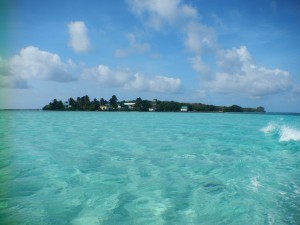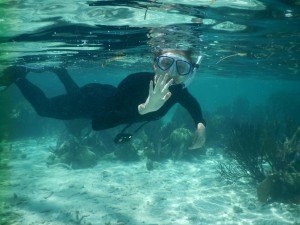This trip was one of the most amazing experiences of my life. Not only did I learn a ton, but I also discovered how fun and rewarding field biology can be.
In visiting both the tropical rainforests and coral reefs of Belize, we were able to experience the two most biologically diverse ecosystems on the planet. Though at first glance these ecosystems may seem very different, they actually share many characteristics that may contribute to their amazing biodiversity. Both tend to exist in the tropics (as seen by the existence of both in Belize), where stable temperatures, large amounts of sunlight, and/or long evolutionary lineages may contribute to extreme biodiversity. Additionally, both rainforests and coral reefs often exist in nutrient-poor environments, and thus nutrients are cycled through the communities rather efficiently.
The rainforest and coral reefs had incredible structural diversity. In general, the rainforest’s structure was provided mostly by plants, while the reef’s was provided mostly by coral colonies. With so much structural diversity comes the creation of a plethora of niches for species to inhabit, thus allowing for many species to exist in the same ecosystem. In both areas, we saw countless species from many different taxa, some of which seemed similar but in reality had slightly different ecological roles. The species compositions of the rainforest and coral reefs were of course very unique. For example, very few mammal species exist in the Belizean reef environments, but a large diversity of mammals exists in the Chiquibul forest.
One specific similarity that I noticed between the rainforest and reefs was the complexity of their trophic pyramids. For example, on a coral reef, a great barracuda could eat a Nassau grouper, who could eat a bluestriped grunt, who could eat a clam, who may filter feed on plankton. This complexity is very interesting, and as the “expert” on mammals and piscivorous fish, I found it really exciting to be able to observe some top predators in the wild.
The only thing that this course did not provide me with was a sighting of a wild jaguar (which only means I need to go back!). It really was everything I could have hoped for. There was more scientific methodology practice than I had expected, but I think this was very helpful for learning about how science works in the field. My favorite part of EBIO 319 was just being able to explore the rainforest ecosystem, whether through early morning walks or camera trap images. My least favorite part was probably the pre-trip preparation (which was a bit stressful), but I think it all paid off in the end.
Three of the most important things that I learned on this trip:
1) Living in a more sustainable way, by focusing on true needs (like hydrate or die) rather than superfluous wants, is incredibly rewarding and strengthening.
2) Seeing an elusive creature (such as a tayra) in the wild, even if it took hours or days of seeing nothing, is absolutely worth the effort.
3) Even with little sleep, few snacks, no internet, cold showers, limited electricity, and lots of ticks, field work felt rejuvenating!
















